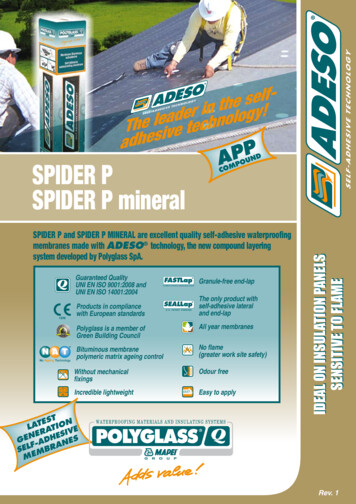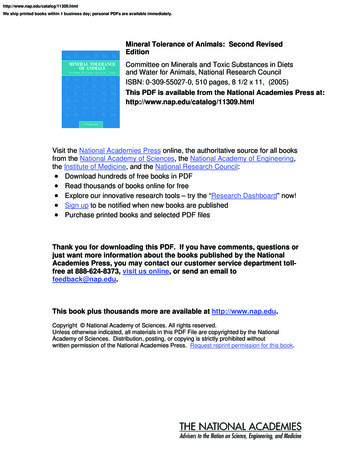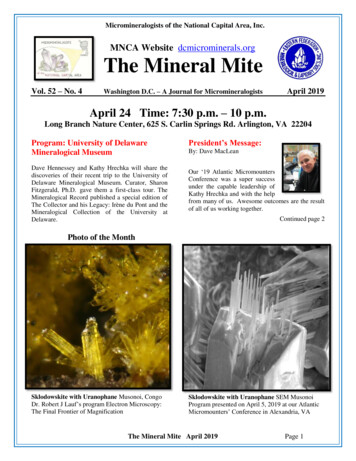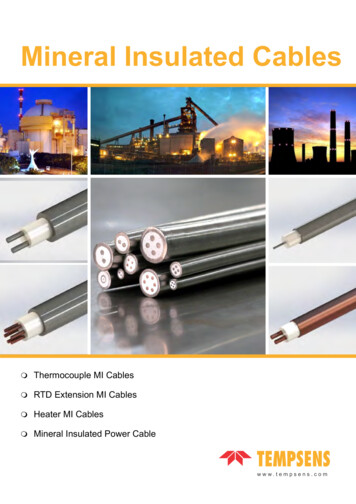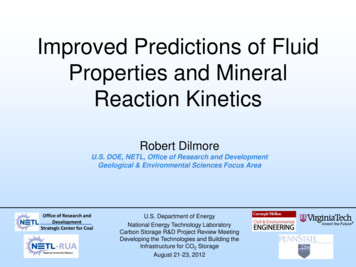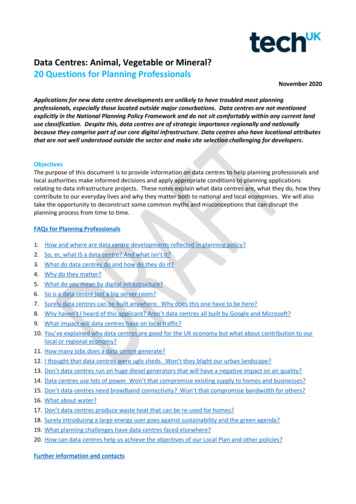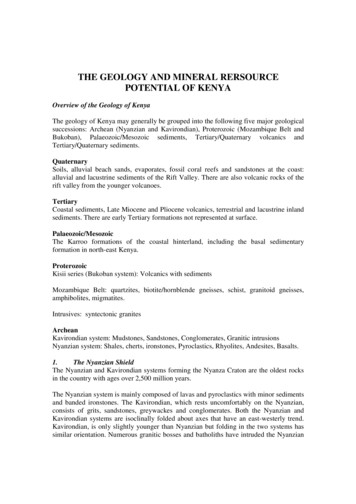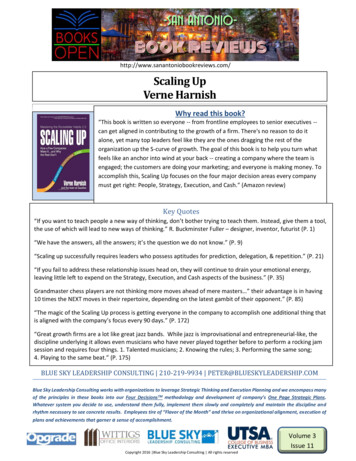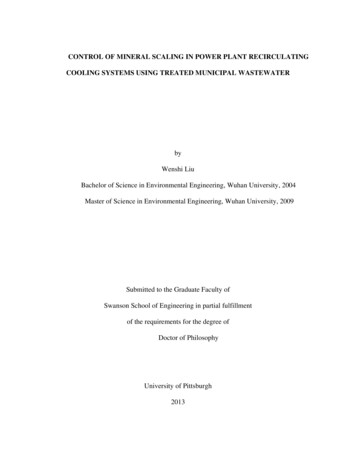
Transcription
CONTROL OF MINERAL SCALING IN POWER PLANT RECIRCULATINGCOOLING SYSTEMS USING TREATED MUNICIPAL WASTEWATERbyWenshi LiuBachelor of Science in Environmental Engineering, Wuhan University, 2004Master of Science in Environmental Engineering, Wuhan University, 2009Submitted to the Graduate Faculty ofSwanson School of Engineering in partial fulfillmentof the requirements for the degree ofDoctor of PhilosophyUniversity of Pittsburgh2013
UNIVERSITY OF PITTSBURGHSWANSON SCHOOL OF ENGINEERINGThis dissertation was presentedbyWenshi LiuIt was defended onMay 2, 2013and approved byRadisav D. Vidic, Ph.D., Professor, Department of Civil and Environmental EngineeringDavid A. Dzombak, Ph.D., Professor, Department of Civil and Environmental Engineering atCarnegie Mellon UniversityLeonard W. Casson, Ph.D., Associate Professor, Department of Civil and EnvironmentalEngineeringKyle Bibby, Ph.D., Assistant Professor, Department of Civil and EnvironmentalEngineeringVikas Khanna, Ph.D., Assistant Professor, Department of Civil and EnvironmentalEngineeringDissertation Director: Radisav D. Vidic, Ph.D., Professor, Department of Civil andEnvironmental Engineeringii
Copyright by Wenshi Liu2013iii
CONTROL OF MINERAL SCALING IN POWER PLANT RECIRCULATINGCOOLING SYSTEM USING TREATED MUNICIPAL WASTEWATERWenshi Liu, Ph.DUniversity of Pittsburgh, 2013The global energy demand is projected to increase by 77% from 2006 to 2030 along with aprojected 38% increase in freshwater withdrawal for cooling in power industry. Findingalternative sources of water for cooling has become essential for future energy generation inthermoelectric power plants because of water scarcity in many parts of the US. Treatedmunicipal wastewater is considered as one of the most promising alternative water sourcesbecause of its geographic distribution and abundant quantity. However, its impaired waterquality makes the cooling tower management more challenging. Therefore, effective approachesare required to prevent scaling, corrosion, and biological growth to promote the reuse of treatedmunicipal wastewater as cooling water in power plants.This study focuses on understanding mineral scale formation and developing effectivemitigation methods when using tertiary treated municipal wastewater as power plant coolingmakeup. Two types of tertiary-treated municipal wastewater that were evaluated includedsecondary-treated water with pH adjustment (MWW pH) and water from secondary-treatmentfollowed by nitrification and sand filtration (MWW NF). Laboratory-scale studies and pilotscale cooling systems were used to evaluate mineral scaling formation and inhibition on nonheated surfaces (e.g., pipelines, tower packing, etc.) under conditions relevant to full-scalecooling systems. Results showed that pH adjustment to 7.8 plus the addition of 5 ppmpolymaleic acid (PMA) could reduce the scaling significantly with MWW pH. MWW NFiv
exhibited little scaling potential, which is related in part to the lower pH and alkalinity in thiswater. Amorphous calcium phosphate (ACP) was the primary form of mineral scale on nonheated surface with the above two-types of tertiary-treated municipal wastewater.A bench-scale experimental system was designed to simulate the condenser surface tostudy the impacts of mineral scaling on the heated surfaces and the effectiveness of proposedscaling control strategies under these conditions. Heated surface favored the formation ofhydroxyapatite (HAP), the most thermodynamically stable calcium phosphate, was the mainreason for the crystalline fouling with MWW pH at pH 7.8. 10 ppm PMA addition couldsuppress the crystalline fouling of MWW pH at 7.8 to a low level by inhibiting thetransformation of amorphous calcium phosphate to hydroxyapatite during the test period.Significant crystalline fouling was identified with MWW NF at pH 7.2 while pH adjustment to7.8 resulted in negligible fouling.The impact of flow velocity on particle deposition was analyzed in a quantitative model,showing positive deposition potential for bulk precipitates at flow velocity of 0.5 and 0.4 m/swhile little particulate fouling was theoretically predicted at 0.6 m/s in the test situation. Benchscale studies were consistent the model prediction, confirming that the model could be used toidentify optimal hydrodynamic conditions to control depositions of bulk precipitates.The mechanism of calcium phosphate scale control by common antiscalants includedPMA and 1-hydroxyethane 1,1-diphosphonic acid (HEDP) was elucidated to provide scientificbackground for the effective scaling mitigation when treated municipal wastewater is used asmake-up in thermoelectric power plant cooling systems. Both PMA and HEDP inhibited thetransformation of ACP to HAP by preventing the aggregation of ACP particles. However, PMAv
dispersed the ACP particles mainly through electrostatic repulsive force while hydration forcewas hypothesized to be the reason for the function of HEDP in dispersion.The key findings of this study indicate that it is possible to control mineral scalingthrough direct chemical addition at proper operating conditions when treated municipalwastewater is used as makeup water in the recirculating cooling system. This study not onlyevaluated scaling control methods in cooling systems, but also revealed the fundamentals ofscaling formation and inhibition.vi
TABLE OF CONTENTSTABLE OF CONTENTS. VIILIST OF TABLES . XILIST OF FIGURES . XIIACKNOWLEDGEMENTS . XVII1.0INTRODUCTION . 11.1 RESEARCH OBJECTIVES . 31.2 SCOPE OF THE DISSERTATION . 42.0SCALING MITIGATION ON NON-HEATED SURFACES WITH TREATEDMUNICIPAL WASTEWATER AS MAKEUP IN RECIRCULATING COOLINGSYSTEMS . 72.1 INTRODUCTION . 92.2 MATERIALS AND METHODS. 112.2.1 Municipal wastewater. 112.2.2 Laboratory experimental systems . 132.2.3 Pilot-scale cooling tower tests . 152.3 RESULTS AND DISCUSSION . 172.3.1 Precipitation reactions in solution: batch tests . 172.3.2 Bench-scale recirculating system tests . 252.3.3 Pilot-scale studies with tertiary-treated MWW . 29vii
2.4 SUMMARY AND CONCLUSION . 403.0SCALING MITIGATION ON HEATED SURFACES WITH TREATED MUNICIPALWASTEWATER AS MAKEUP IN RECIRCULATING COOLING SYSTEMS. 423.1 INTRODUCTION . 443.2 MATERIALS AND METHODS. 463.2.1 Secondary- and tertiary-treated MWW . 463.2.2 Batch tests. 473.2.3 Bench-scale recirculating system for fouling studies . 483.3 RESULTS AND DISCUSSION . 523.3.1 Bulk precipitation studies . 523.3.2 Crystalline fouling in bench-scale recirculating system . 573.3.3 Particulate fouling in bench-scale recirculating system . 623.4 SUMMARY AND CONCLUSIONS . 674.0 INSIGHTS INTO CALCIUM PHOSPHATE SCALE MITIGATION BY TYPICALANTISCALANTS . 694.1 INTRODUCTION . 704.2 MATERIALS AND METHODS. 734.2.1 Test solution . 734.2.2 Antiscalants . 744.2.3 Batch tests. 744.3 RESULTS AND DISCUSSION . 764.3.1 Calcium phosphate precipitation . 764.3.2 Function of antiscalants on the calcium phosphate precipitation . 834.3.3 Mechanism of antiscalant effect on the calcium phosphate precipitation . 864.4 SUMMARY AND CONCLUSIONS . 90viii
5.0 SUMMARY, CONCLUSIONS AND FUTURE WORK . 925.1 SUMMARY AND CONCLUSIONS . 925.1.1 Mineral scaling mitigation on non-heated surfaces with tertiary-treated municipalwastewater as cooling system makeup . 935.1.2 Crystalline fouling mitigation on the heated surfaces with tertiary-treatedmunicipal wastewater as cooling system makeup . 935.1.3 Impact of hydrodynamic conditions on the particulate fouling. 945.1.4 Mechanism of common antiscalants on the calcium phosphate precipitation . 945.1.5 Overall findings . 955.2 KEY CONTRIBUTIONS . 965.3 FUTURE DIRECTIONS . 975.3.1 Development of a predictive model for heat exchanger fouling when treatedmunicipal wastewater is used as cooling makeup . 975.3.2 Elucidation of mineral-antiscalants interactions for improved scaling andcorrosion inhibition. 995.3.3 Engineering of substrate surface materials for mineral scaling mitigation . 100APPENDIX A TWO PATHWAYS FOR MINERAL SCALE FORMATION: SURFACECRYSTALLIZATION AND PARTICLE DEPOSITION . 102A.1 INTRODUCTION AND APPROACH . 102A.2 RESULTS AND DISCUSSION . 103A.2.1 Forces analysis on the individual particle deposited on the pipe surface. 103A.2.2 Critical shear flow velocity to detach the individual scale particle deposited onthe pipe surface . 110A.3 SUMMARY AND CONCLUSIONS . 114APPENDIX B REPRODUCIBILITY OF THE FOULING RESISTANCE MEASUREMENT INTHE BENCH-SCALE RECIRCULATING SYSTEM FOR FOULING STUDIES . 115B.1 MATERIALS AND METHODS. 115ix
B.2 RESULTS AND DISCUSSION . 116APPENDIX C SCALING MITIGATION FOR MWW NFG AS MAKEUP FOR COOLING 117C.1 INTRODUCTION . 117C.2 MATERIALS AND METHODS. 118C.3 RESULTS AND DISCUSSION . 119C.4 SUMMARY AND CONCLUSIONS . 127BIBLIOGRAPHY . 128x
LIST OF TABLESTable 1.1 Main contents in each chapter of this study . 6Table 2.1 Key water quality parameters of Franklin Township Municipal Sanitary Authority(Murrysville, PA) secondary treated effluent (Sampled on September 3, 2008) . 12Table 2.2 Chemical composition of synthetic MWW and MWW NF at 4 cycles of concentration(CoC 4) for batch- and bench-scale experiments . 13Table 2.3 Chemical composition of synthetic MWW and MWW NF at 4 cycles of concentration(CoC 4) for batch- and bench-scale experiments . 17Table 2.4 Langelier Saturation Index (LSI) of the recirculating water in Towers A, B and C inpilot-scale tests with MWW pH . 32Table 2.5 Langelier Saturation Index of the recirculating water in Towers A, B and C in pilotscale tests with MWW NF on days 36, 40, 44, 49, and 54 . 37Table 3.1 Chemical composition of synthetic MWW and MWW NF at 4 cycles of concentration(CoC 4) used in the scaling study on heated surface . 46Table 3.2 Experimental parameters and typical conditions in recirculating cooling systems atthermoelectric power plants . 51Table 4.1 Chemical compositions of the test solution used in the study for the antiscalants oncalcium phosphate precipitation. 73Table 4.2 Solubility of amorphous calcium phosphate at 25 C, 30 C, 40 C, and 45 C . 82Table A.1 Useful parameters to calculate the forces acting on the individual scale particledeposited on the stainless steel pipe surface . 112Table C.1 Langelier Saturation Index for the recirculating water in Towers A, B, and C duringthe pilot-scale cooling tower test, summer 2011. 123xi
LIST OF FIGURESFigure 2.1 Schematic diagram of bench scale recirculating system . 15Figure 2.2 Residual Ca and phosphate concentrations in batch tests with synthetic secondarytreated MWW (CoC 4) as a function of time at typical cooling water temperature(40 C) when pH was maintained at 8.4, 8.2, 7.8, 7.4, and 7.0. The data represent meanvalues based on triplicate measurements with relative standard deviation (%RSD) ofCa and phosphate concentration measurements within 5.2% and 3.1%, respectively. 18Figure 2.3 XRD pattern of the precipitates from batch tests with synthetic secondary-treatedMWW (CoC 4, 40 C) when pH was maintained at pH 8.4, 8.2, 7.8, and 7.4 . 19Figure 2.4 SEM image and the elemental composition of the precipitates from batch tests withsynthetic secondary-treated MWW (CoC 4, 40 C) when pH was maintained at pH 7.4.EDS scan was performed on the area outlined by the square box on the SEM image. 20Figure 2.5 SEM images of precipitates from batch tests with synthetic secondary-treated MWW(CoC 4, 40 C) when pH was maintained at different value: (a) pH 8.2; (b) pH 7.8 . 21Figure 2.6 Residual Ca and phosphate concentrations in batch tests with synthetic secondarytreated MWW (CoC 4) as a function of time at typical cooling water temperature(40 C) when 0, 5, 7, and 10 ppm PMA was dosed at different pH: (a) 8.4; (b) 7.8. . 23Figure 2.7 SEM images of precipitates from batch tests with synthetic secondary-treated MWW(CoC 4, 40 C) when pH was maintained at 7.8 with the addition of 5 ppm PMA . 24Figure 2.8 Residual Ca and phosphate concentrations in batch tests with synthetic MWW NF(CoC 4) as a function of time at typical cooling water temperature (40 C). The datarepresent mean values based on triplicate measurements with relative standarddeviation (%R RSD) of Ca and phosphate concentration measurements within 4.3%and 2.6%, respectively. . 25Figure 2.9 Scaling behavior of synthetic MWW under different scaling control strategies inbench-scale recirculating system tests: (a) MWW pH ; (b) MWW NF. The bulk watertemperature and flow velocity was maintained at 40 C and 0.6 m/s respectively. Errorbars indicate the data range of measurements from duplicate tests. The bulk waterxii
temperature and flow velocity were maintained at 40 C and 0.6 m/s respectively. Errorbars indicate the data range of measurements from duplicate tests. . 27Figure 2.10 SEM images of the mineral deposits collected on the stainless disc specimens frombench-scale recirculating system tests under different scaling mitigation strategies: (a)pH control at 8.4; (b) pH control at 8.4 plus 5 ppm PMA; (c) pH control at 7.8; (d) pHcontrol at 7.8 plus 5 ppm PMA . 28Figure 2.11 “Green deposits” retained on 0.45 µm filter paper after filtering the recirculatingwater in Tower B on day 9 in pilot scale tests with MWW pH at pH 7.0 . 30Figure 2.12 Coupons collected from pilot-scale cooling towers tests with MWW pH on day: (a)Tower A (5 ppm PMA for scaling control); (b) Tower B (5 ppm PMA and pHadjustment for scaling control); (c) Tower C (5 ppm PMA and pH adjustment forscaling control) . 31Figure 2.13 Inorganic deposit mass measurements in the pilot-scale cooling tower tests withMWW pH . 31Figure 2.14 Orthophosphate concentration in the make-up water and recirculating water in thepilot-scale cooling tower tests with MWW pH . 33Figure 2.15 SEM images and the elemental composition of the solid deposits collected onsta
May 02, 2013 · treated MWW (CoC 4) as a function of time at typical cooling water temperature (40 C) when pH was maintained at 8.4, 8.2, 7.8, 7.4, and 7.0. The data represent mean values based on triplicate measurements with relative standard deviation (%RSD) of Ca and phosphate concent
